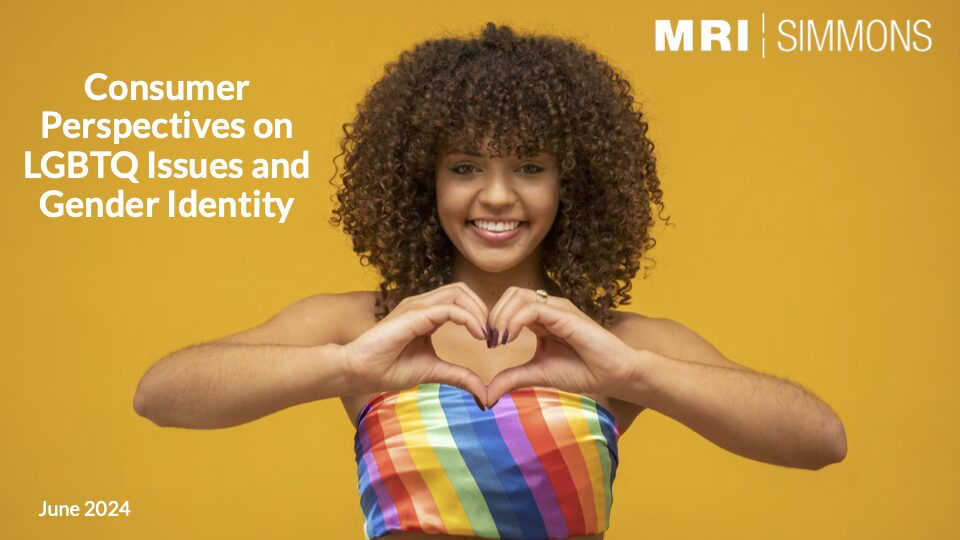Engaging LGBTQ Allies in Brand Campaigns
As the United States grapples with issues of transgender rights, the landscape around gender identity and sexual orientation continues to evolve. MRI-Simmons’ LGBTQ and Gender Identity Study reveals Americans hold a complex set of views on these matters and how inclusive values reflect Americans’ beliefs. In advertising, practicing inclusivity in an authentic way is essential for brands to connect with diverse audiences and foster positive brand perception – and the majority of Americans agree.
Support for the LGBTQ Community
In the landscape of American values and beliefs, support for the LGBTQ community is a common and crucial topic. 63% of American adults support LGBTQ rights (levels similar year over year), with younger generations leading the charge. This trend presents a compelling opportunity for marketers, as these supporters are not only numerous but also influential, often setting the tone for cultural conversations and consumer behavior across most product categories. LGBTQ allies can be a key audience for brand activation.
The personal connection to LGBTQ individuals is widespread, with 67% of Americans knowing someone within the community, up 8 points from just two years ago. This statistic rises to 73% among women and 74% among Hispanic Americans, underscoring the community’s broad reach across demographic lines. Marketers can tap into this network of allies and advocates, who are likely to respond positively to campaigns that reflect their inclusive values.
Why target LGBTQ community allies?
Many Americans are passionate about LGBTQ causes
73% of Americans back HIV education support, and 65% are in favor of anti-bullying initiatives for LGBTQ youth. Over 60% support efforts to reduce discrimination of transgender Americans in areas of employment and housing, and over half support the expansion of LGBTQ roles in politics and religion. Marketers can align their campaigns with these causes to resonate with the majority of Americans who care.
LGBTQ safety concerns persist
Despite progress, 26% of Americans believe that LGBTQ people are not safe at churches or religious services, and 19% feel they’re not safe at both large-scale and local sporting events. This indicates a need for environments where inclusivity is not only supported but also actively protected. Brands that align themselves with these causes can build trust and loyalty among consumers who care about safety for all Americans, wherever they want to go.
The entertainment industry reflects a growing appetite for diversity
45% of Americans are keen on seeing gender-fluid and LGBTQ characters in TV shows and movies. This interest mirrors today’s diverse human experiences, offering marketers a chance to connect with audiences through storytelling that celebrates all identities. Brands can represent different ethnicities, genders, ages, abilities, and body types. Authentic diversity in entertainment helps consumers see themselves in your brand and fosters a sense of belonging. Representation matters.
Diversity is not quite normalized
While a slight majority of Americans support conversations around gender diversity, there’s still discomfort. 67% like knowing concretely what gender someone is, and 49% find gender diversity uncomfortable. In my opinion, marketers can play a role in educating consumers and normalizing diverse gender expressions. A tactic to promote inclusivity in advertising could be to use language that is inclusive and respectful, avoiding gender-specific terms unless necessary, to foster gender diversity conversations.
Supporters of LGBTQ are spenders
The 34% of Americans who are "very" supportive of the LGBTQ community are more likely to be fiscal optimists, showing confidence in their financial situation and that of the US economy as well. While their average household income is around $112k, they over index for being in the free-spirited shoppers and passionate travel adventurers segments, with an increased likelihood of making impulse purchases, considering themselves “spenders” rather than “savers”, and making adventures and travel a top priority in life. By connecting your marketing message with the ideals of LGBTQ allies, brands can reap the benefits of their spending power and willingness to support a brand that stands up for the LGBTQ community.
The segments in the chart are defined below:
- Passionate Travel Adventurers: Travel is a passion and a priority for this segment. They travel to seek adventure and thrills, meet new people, and learn about new cultures. This group looks for vacation experiences different from their friends, and they are called on by others to give advice on travel.
- My Products Scream Green: Being green is a growing priority; they are interested in learning more about being environmentally progressive. This group is starting with the little things – cleaning products, recycled products – and are involved with environmental groups and causes.
- Married to My Screen: This group uses their phone for everything, and they say that apps have made their life more convenient. They consider their device an extension of their personality, and it even can take precedence over face-to-face conversations. They use their phones for shopping, entertainment, social media (including following brands and companies), apps, and more, which includes staying in touch with friends and family.
- Fiscal Optimists: This group is confident about their current fiscal situation, as well as that of the US economy overall. They have positive expectations about the fiscal future as well.
- Fashionistas: Making a unique and trendy fashion statement is key to this group’s image. They like to experiment with new styles, mix and match low- and high-end fashion, and are the first among their friends to try new clothing styles. They pay attention to social media influencers and like to spend money to get the newest and best styles.
- Free-Spirited Shoppers: This group is likely to make impulse purchases and defines themselves as spenders rather than savers. If they really want something, be it the newest technology or the most environmentally friendly, they will buy it with credit rather than wait.
While not for every brand, marketers can recognize that over one third of Americans (37%) are involved in LGBTQ and gender diversity topics (either actively educating themselves, being an ally, or serving as an activist). You can tailor your messaging to resonate with these supportive segments. For some brands, your audience may hold more conservative, traditional values and better reflect the 37% of Americans who do not support LGBTQ – for which over half attribute their non-support to believing in the traditional American family. Remember, promoting inclusivity isn’t just about ticking boxes—it’s about genuinely valuing and celebrating your audience’s lived experiences.
Activate with MRI-Simmons ACT
Through MRI-Simmons' activation solution, ACT, marketers can leverage trusted and nationally representative data to target and reach LGBTQ allies. Curate your audience with over 60,000 consumer elements: 1000+ attitudes and opinions, 6500+ brands in 1000+ product categories; and 90+ proprietary segments. Then, activate via the DMP, DSP, SSP, MVPD, or programmer of your choice.

Download the report!
Want to learn more about Americans’ attitudes toward gender identity and sexual orientation? Download our complimentary report 'Consumer Perspectives on LGBTQ Issues and Gender Identity' which provides some insights into American support for the LGBTQ community and related issues.
To learn more about MRI-Simmons or its LGBTQ and Gender Identity Study, contact us today.
Source: 2024 June LGBTQ and Gender Identity Study (F23 DB USA).




